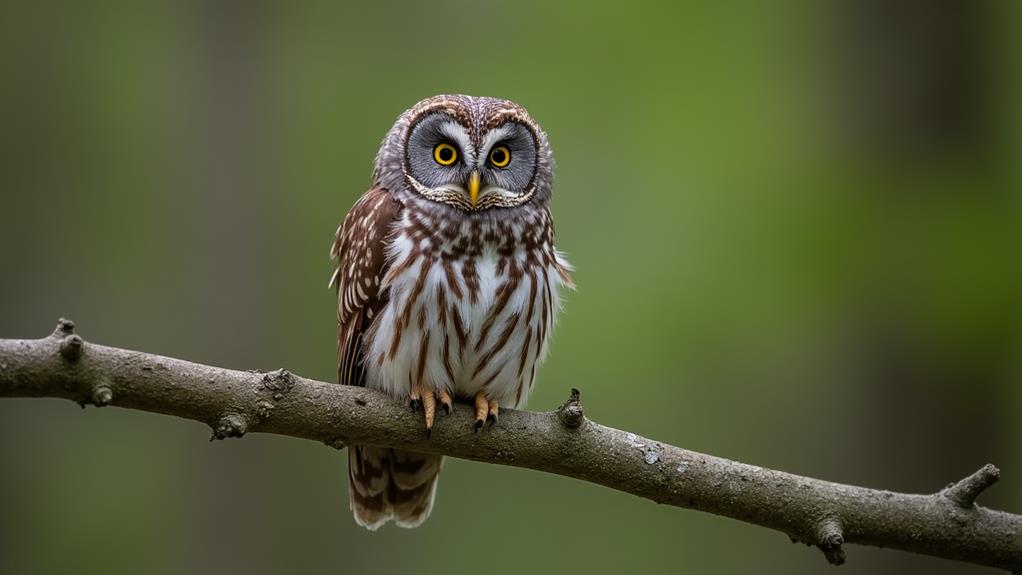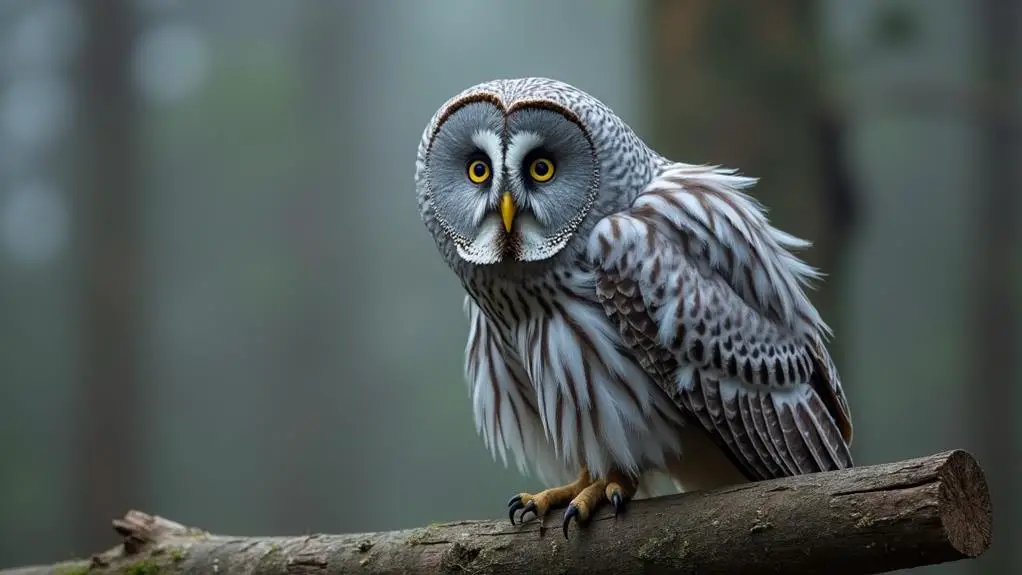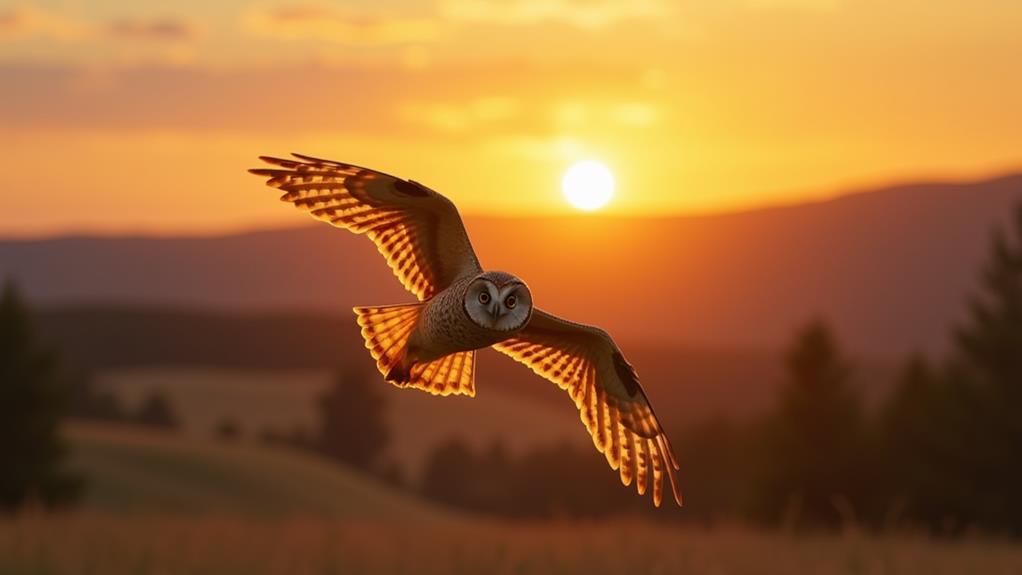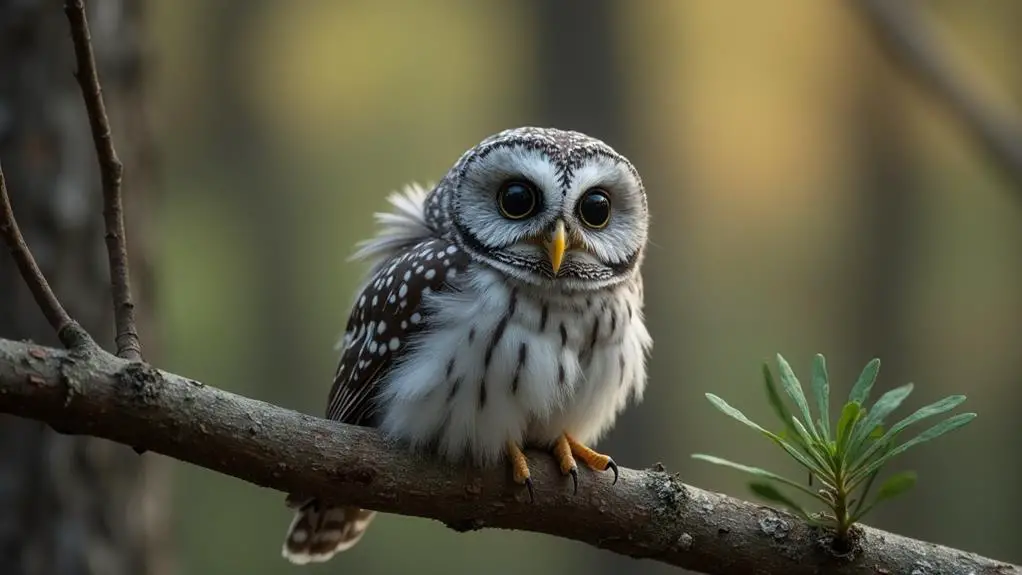As it happens, you've decided to take a nighttime stroll through Tennessee's woods just as the owl breeding season is in full swing. You've probably heard the haunting calls of these nocturnal birds, but do you know which species you're listening to? With ten distinct owl species calling Tennessee home, it can be a challenge to identify them. From the urban Eastern Screech Owl to the rural Great Horned Owl, each has unique characteristics and habits that set them apart. But what are the key differences between these birds, and how can you tell them apart?
Key Takeaways
- The Eastern Screech Owl is found in urban and suburban Tennessee, identified by its distinctive whistled call and small size.
- The Great Horned Owl is found in rural and wilderness areas, recognized by its large size and deep, hooting calls.
- The Barred Owl inhabits mature Tennessee forests, identified by its "who-cooks-for-you" call and mottled brown plumage with horizontal bars.
- The Great Gray Owl prefers open areas with low vegetation in northern and eastern Tennessee, featuring a rounded head and mottled gray plumage.
- The Barn Owl is found in open fields and grasslands, distinguished by its heart-shaped face, pale underside, and golden-brown upperparts.
Eastern Screech Owl

Several Eastern Screech Owls can be found in Tennessee, particularly in the state's urban and suburban areas.
You can identify them by their distinctive owl calls, which sound like a descending whistled phrase, often described as a "whinny" or a series of short, high-pitched notes. These calls are typically heard at dawn and dusk, and are used for contact and territorial purposes.
Eastern Screech Owls are small, measuring 6-10 inches in length, with a wingspan of 18-24 inches.
They've a rounded head, a short neck, and a mottled brown or gray plumage. You may notice that they've a distinctive facial disk, which helps them to funnel sound towards their ears.
Despite their small size, Eastern Screech Owls are skilled hunters, preying on insects, small mammals, and birds.
One common owl myth is that they prey on domestic pets, but this is largely unsubstantiated. In fact, Eastern Screech Owls are generally beneficial to have around, as they help to control pest populations.
Great Horned Owl
In contrast to the Eastern Screech Owl's urban and suburban habitats, Great Horned Owls in Tennessee tend to inhabit more rural and wilderness areas, often near water sources like lakes, rivers, or swamps.
As a Silent Hunter, the Great Horned Owl relies on stealth and camouflage to catch its prey. Its Nocturnal Adaptations, such as exceptional night vision and acute hearing, enable it to thrive in low-light environments.
When identifying Great Horned Owls in Tennessee, consider the following characteristics:
- Large size, typically 22-27 inches in length
- Distinctive ear tufts, resembling horns
- Mottled brown and gray plumage, providing camouflage in woodland environments
- Powerful talons, adapted for grasping and killing prey
- Deep, hooting calls, often described as a low, mournful sound
As you explore Tennessee's rural landscapes, keep an ear out for the Great Horned Owl's haunting calls, and a sharp eye out for its distinctive silhouette.
With its impressive size and formidable hunting abilities, the Great Horned Owl is a force to be reckoned with in the state's nocturnal ecosystem.
Barn Owl

Tennessee's rural landscapes also support another iconic owl species, the Barn Owl.
You'll likely find them in open fields, grasslands, and agricultural areas, where they hunt for small mammals like rodents and shrews.
As a cavity-nesting bird, Barn Owls often roost in abandoned barns, silos, or other structures, which has led to their reputation as farm friends.
Contrary to nocturnal myths, Barn Owls aren't exclusively active at night.
They're also crepuscular, meaning they can be active during twilight hours.
This unique behavior allows them to capitalize on the abundance of rodents during these times.
When identifying a Barn Owl, look for its distinctive heart-shaped face, pale underside, and golden-brown upperparts.
They also have a characteristic "screeching" call, which sounds like a loud, drawn-out scream.
In flight, Barn Owls display a slow, wingbeat pattern and often hover above the ground, scanning for prey.
If you're lucky, you might catch a glimpse of this owl species in action, especially during the breeding season, which typically runs from March to August in Tennessee.
Barred Owl
When you encounter a Barred Owl in Tennessee, you'll notice its key identifying features, such as its distinctive "who-cooks-for-you" call and mottled brown plumage with horizontal bars on its chest.
You'll typically find this owl in mature forests with dense canopies, where it breeds and inhabits a variety of habitats, including swamps and woodlands.
As you observe the Barred Owl's behavior, you'll see that it preys on a range of small mammals, birds, and reptiles, showcasing its adaptability as a hunter.
Key Identifying Features
Identifying a Barred Owl relies heavily on its distinct physical characteristics, which set it apart from other owl species in Tennessee.
You'll notice the owl's overall brown plumage, with horizontal stripes on its chest and vertical stripes on its belly.
When observing the Barred Owl, pay attention to the following key features:
* Facial patterns: The owl's face is round, with a flat facial disk and a distinctive "who-cooks-for-you" call.
The facial disk is bordered by a dark brown stripe that extends from the beak to the back of the head.
* Wing shapes: The owl's wings are long and rounded, with a broad wing tip.
This shape allows for silent, slow flight.
- Beak shape: The beak is short, yellow, and hooked, perfect for tearing flesh.
- Legs and feet: The owl's legs are long and feathered, with strong, zygodactyl feet.
- Size: The Barred Owl is a medium-sized owl, measuring 20-24 inches in length and weighing 1.5-2.5 pounds.
Breeding and Habitat
You've got a good sense of the Barred Owl's distinct physical characteristics, now let's see how these traits serve it in its breeding and habitat.
The Barred Owl's habitat consists of mature forests, often near water sources, where it can find suitable nesting sites.
It typically breeds in the spring, with mating rituals beginning in February or March. During this time, the male Barred Owl will engage in a variety of displays to attract a female, including vocalizations and aerial displays.
Once a pair has formed, they'll begin working on their nesting site, often taking over an existing nest or cavity. The female will lay 2-4 eggs, which she'll incubate for approximately 30 days.
The male will provide food for the female during this time, and both parents will care for the young once they hatch.
The Barred Owl's nesting habits are monogamous, with pairs forming during the breeding season and staying together for multiple years.
They're also known to be territorial, with pairs defending their territory from other Barred Owls.
Typical Prey Options
In its natural habitat, adaptability plays a key role in the Barred Owl's hunting success.
You'll find that this owl's diverse prey base is a testament to its ability to thrive in various environments.
The Barred Owl's diet consists mainly of small mammals, nocturnal insects, and occasionally, other birds.
When it comes to its typical prey options, you can expect to see the following:
- Small mammals, such as voles, mice, and shrews, which are often caught on or near the ground
- Nocturnal insects, including crickets, beetles, and caterpillars, which are caught in mid-air or plucked from vegetation
- Birds, such as songbirds and woodpeckers, which are taken from trees or caught in flight
- Amphibians, like frogs and toads, which are caught near water sources
- Reptiles, including snakes and lizards, which are taken from trees or caught on the ground
These prey options are a reflection of the Barred Owl's opportunistic feeding behavior, which allows it to take advantage of whatever is available in its environment.
Great Gray Owl

When you encounter a Great Gray Owl in Tennessee, you'll likely find it in the state's northern and eastern regions, where open areas with low vegetation provide suitable habitat.
You'll notice this owl's distinctive physical characteristics, including a rounded head, a flat facial disk, and ear tufts that resemble small horns.
Its overall size and mottled gray plumage will also set it apart from other owl species in the state.
Habitat and Distribution
They prefer coniferous and boreal forests for their primary habitats, and these forests' varied structure – ranging from sparse open stands to denser vegetation – creates optimal living environments for the Great Gray Owls.
As you explore the habitats of these birds, you'll notice that they often inhabit areas with a mix of forest landscapes and woodland edges.
This diversity of habitats allows the Great Gray Owls to thrive in a variety of environments.
When searching for Great Gray Owls in Tennessee, consider the following key aspects of their habitat and distribution:
- Forest landscapes with a mix of coniferous and deciduous tree species
- Woodland edges with dense vegetation and open areas for hunting
- Areas with low to moderate elevations, typically below 2,000 feet
- Regions with abundant small mammal populations, such as voles and mice
- Habitats with minimal human disturbance and fragmentation
Physical Characteristics
Great Gray Owls' adaptable nature in their Tennessee habitats is closely tied to their distinctive physical characteristics.
When you observe these owls, you'll notice their mottled gray and brown plumage, which serves as effective camouflage in their forested and woodland environments.
You'll also notice their rounded head, forward-facing facial disk, and yellow eyes. These features are typical of owls and allow them to efficiently locate prey in low light conditions.
The Great Gray Owl's wings are broad and rounded, with distinctive wing patterns that help them fly silently and maneuver through dense vegetation.
One of their most distinctive physical characteristics is their beak shape. Great Gray Owls have a short, hooked beak that's well-suited for their diet of small mammals, such as voles and lemmings.
You'll notice that their beak is relatively small compared to other owl species, but it's highly effective for ripping flesh and crushing bone.
When identifying Great Gray Owls, pay attention to their overall size and shape. They're one of the largest owl species in Tennessee, with a length of up to 33 inches and a wingspan of up to 5 feet.
Their distinctive physical characteristics make them a striking sight in the wild.
Burrowing Owl
Tennessee's grasslands and open fields are the primary habitat for the Burrowing Owl, a unique and intriguing species that's distinct from other owl species.
As its name suggests, this owl is known for its burrowing habits, often taking over abandoned burrows from other animals like ground squirrels or prairie dogs.
You can identify a Burrowing Owl by its distinctive physical characteristics, but it's essential to understand its behavior and habitat to spot one in the wild.
When it comes to owl migrations, the Burrowing Owl is a partial migrant, meaning some populations migrate, while others remain in their year-round habitats.
Burrowing Owls are listed as Endangered in Tennessee, so sightings are rare.
- They're active during the day, but also hunt at night, making them a challenge to spot.
- Their primary source of food is small mammals, like rodents and insects.
- Burrowing Owls are monogamous, with pairs forming during breeding season.
- They're known for their long, slender legs, which they use to run and hunt.
Short-Eared Owl

Open fields and grasslands in Tennessee also provide a habitat for the Short-Eared Owl, a species that shares some similarities with the Burrowing Owl in terms of its preference for open spaces.
As you observe this owl, you'll notice its flight patterns are characterized by slow, wingbeats, and a tendency to fly low over the ground. This unique flight pattern allows the Short-Eared Owl to effectively scan its surroundings for prey.
When it comes to hunting strategies, the Short-Eared Owl relies on its exceptional hearing and vision to locate small mammals, such as voles and mice.
It's not uncommon for this owl to perch on a fence post or low-lying branch, scanning the surrounding area for signs of movement. Once it detects prey, the Short-Eared Owl will swoop down, using its acute hearing to pinpoint the location of its quarry.
This owl's hunting strategy is often described as "perch-hunting," where it uses a vantage point to scan for prey before making a swift and decisive strike.
Long-Eared Owl
As you delve into the world of nocturnal birds in Tennessee, you'll find the Long-Eared Owl, a species that thrives in dense, deciduous forests.
This medium-sized owl is known for its long ear tufts, which give it a distinctive appearance.
The Long-Eared Owl's mysterious habits make it a challenging bird to study, but researchers have made some key observations:
- The Long-Eared Owl is a non-breeding migratory species in Tennessee, with most individuals passing through the state during the fall and spring.
- These owls are cavity-nesting birds, often using old woodpecker nests or natural tree cavities.
- Long-Eared Owls are skilled hunters, preying on small mammals like voles and mice.
- Their long ear tufts are thought to be an adaptation for camouflage, helping them blend in with their surroundings.
- The Long-Eared Owl's long eared calls are a series of whistled notes, often described as a low, mournful "hoo-h'ooh".
Northern Pygmy Owl

Among the smallest owl species in North America, the Northern Pygmy Owl is a year-round resident in Tennessee, with its population scattered throughout the state's mountainous regions.
You'll find these forest dwellers inhabiting coniferous forests, often near the forest edge or in areas with dense undergrowth. Their small size and ability to fly silently make them well-suited to hunting in dense vegetation.
The Northern Pygmy Owl's diet consists mainly of small mammals, birds, and insects. They're diurnal, meaning they hunt during the day, which sets them apart from many other owl species.
If you're trying to spot one, look for a small, round head, white facial disk, and yellow eyes. Their plumage is brown and white, with a distinctive white stripe above their eyes.
The Northern Pygmy Owl's conservation status is currently listed as Least Concern by the International Union for Conservation of Nature (IUCN). However, habitat loss and fragmentation due to urbanization and logging may pose a threat to their populations in the future.
As you explore Tennessee's mountainous regions, keep an eye out for these tiny owls and their unique characteristics.
Elf Owl
When you encounter an Elf Owl in Tennessee, you'll notice its small size, typically measuring 6-7 inches in length, and its distinctive white eyebrows and yellow eyes.
You'll likely find this owl in open woodlands, urban areas, and backyards with trees, as it's adapted to a variety of habitats.
As you observe the Elf Owl's behavior, you'll see that it's a nocturnal hunter, using its acute hearing and exceptional vision to catch insects and small vertebrates.
Physical Description
Characterizing the smallest owl species in North America, the Elf Owl's physical description sets it apart from other Tennessee owl species.
As you examine this bird, you'll notice distinct features that differentiate it from larger owl species.
To accurately identify the Elf Owl, focus on its unique physical characteristics:
- The Elf Owl has a round head with no ear tufts, a distinguishing feature that separates it from other owl species.
- Its back and wings exhibit a brownish-gray color with a distinctive pattern of white or pale brown bars on the feathers.
- The Elf Owl's underside is pale gray to white with narrow brown stripes.
- Its facial disk is pale yellow, surrounded by a dark brown border that helps distinguish it from other owl species.
- Its small wings display a mottled brown and gray wing pattern with a pale underside.
The Elf Owl's wing patterns and feather colors play a significant role in identifying the species.
The distinct arrangement of feathers on its back and wings can be seen in flight or at rest.
When examining an Elf Owl's physical description, take note of the characteristic coloration and pattern, as this is key to identifying this species among others in Tennessee.
Habitat and Behavior
The Elf Owl inhabits woodlands with dense tree cover, particularly those dominated by deciduous and evergreen trees, where its small size allows it to navigate through dense foliage.
You can find these owls in forest dwellings with an abundance of tree cavities, which they use as nesting sites. As a cavity-nesting species, Elf Owls often take over existing nests or excavate their own in dead or dying trees.
As a nocturnal bird, the Elf Owl's behavior is adapted to its nighttime environment.
You'll notice that they're most active at dusk and dawn, when they hunt for small insects, reptiles, and amphibians. Their nocturnal habits also influence their communication patterns, with a distinctive whistling call that echoes through the forest at night.
When you're observing Elf Owls in their natural habitat, be prepared to listen for this high-pitched call, which can be a key identifier for the species. By understanding the Elf Owl's habitat and behavior, you'll be better equipped to spot this elusive bird in Tennessee's woodland environments.
Frequently Asked Questions
How Do Owls Protect Themselves From Predators?
When encountering predators, you observe owls exhibit fear responses, such as freezing or fleeing, to avoid detection. Effective predator avoidance strategies also include camouflage, nocturnal behavior, and swift flight, helping them protect themselves from potential threats.
Can Owls See in Complete Darkness?
You often wonder if owls can see in complete darkness, thanks to exceptional night vision and dark adaptation. Their large pupils, tapetum lucidum, and high rod-to-cone ratio enable superior low-light sensitivity, though not true complete darkness visibility.
What Is the Average Lifespan of Owls?
You're pondering the owl's lifespan, a query that's been hooting in your mind like the town crier of yore. Owls' average lifespan varies, influenced by hunting habits and nesting habits, ranging from 2-10 years in the wild, and up to 20 in captivity.
Do Owls Make Good Pets for Beginners?
When considering owl ownership, you'll face unique pet care challenges. Understanding owl ownership basics is crucial, as these birds require specialized care and housing, making them unsuitable for most beginners due to their complex needs.
How Do Owls Drink Water Naturally?
When you observe owls' water intake strategies, you'll see they use beak adaptation methods, such as dipping their beaks into water and tilting their heads back to swallow, eliminating the need to scoop water.
Conclusion
You've now explored the 10 owl species that inhabit Tennessee. Investigating the theory that habitat diversity supports a wide range of owl species, it's clear that this holds true in the state. From urban areas to rural regions, open fields to dense woodlands, and mountainous regions, each owl species has adapted to its unique environment. This adaptability underscores the importance of preserving diverse habitats to support the rich owl biodiversity in Tennessee.





